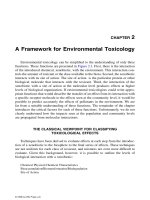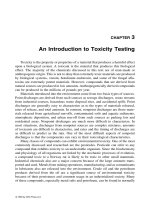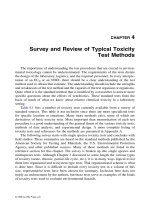Introduction to environmental economics
Bạn đang xem bản rút gọn của tài liệu. Xem và tải ngay bản đầy đủ của tài liệu tại đây (1.01 MB, 30 trang )
Introduction to
Environmental Economics
Objectives
After studying this chapter you should be able to:
Explain the basic functioning of the traditional
economic system & its limitations as far as the
environment is concerned
Explain the relationships between the economic &
environmental systems
Explain the laws of thermodynamics & their
implications for the economic-environment system
Describing various approaches to incorporating
environmental concerns into economic models
Explain how intervention can take account of the
negative externalities in production
Introduction
What is the Natural Environment?
Comprises 2 types of resources:
1.
2.
Renewable Resources (RR)
Non-Renewable Resources (NRR)
Renewable Resources (RR)
1.
Biological resources that have the capacity for regeneration
Examples incl. forests, animals
•
•
Non-Renewable Resources (NRR)
2.
Finite in supply
3 sub-classes
•
•
•
•
•
Exhaustible Resources – coal, oil
Recyclable Resources – tin, copper, gold
NRR with renewable service flows – land, sea, rivers
Introduction Contd…
A RR can become a NRR if not properly managed
Brings to the fore the issue of sustainability
Traditional Economic systems tend to ignore the role of
the environment
For sustainable development to occur, must consider the
relationship between the economy and the environment
Ecological Economics
Concerned with the interaction between the economy
and the environment
NATURAL RESOURCE ECONOMICS only concerned
with optimal extraction & therefore depletion of RR &
NRR
ENVIRONMENTAL ECONOMICS concerned with the
environment, pollution & ways to minimise the negative
impact of economic activity on economy
Ecological economics considers all of the above as well
as social & ethical issues
To explain the main difference between
Ecological Economics & Natural Resource
Economics:
Assume we start with a FOREST
Natural Resource Eco’s looks at the optimal rate of extraction of
the trees (the Maximum Sustainable Yield) given a range of
factors (interest rates, stumpage, tree growth rates)
Ecological Eco’s looks at how this exploitation will affect the
rights of future generations & other forms of life in the
ecosystem, such as birds, insects, wildlife, etc…
How else does Ecological Eco’s differ from
traditional economics?
Neoclassical eco’s based on
• Rational economic behaviour of cost minimisation or profit
maximisation
• Views environmental problems as an externality problem
Ecological eco’s
• Takes social & ethical issues into account
• Views environment as integral part of the economic system
EVOLUTION
Changes in the gene pool that is common to a group
of organisms belonging to the same species
Enables species to adapt to its environment through
selective replacement of weaker individuals
SPACESHIP EARTH
Human beings live in a closed system (the earth) &
are dependent on it for sustenance
The earth only receives the sun’s energy
Economic-Environment Systems
What is a system?
• Collection of objects that are bounded in space
and time
• Entities interact through processes
ISOLATED SYSTEM: Neither energy nor matter is
exchanged with surrounding environment
CLOSED SYSTEM: energy is exchanged with
surrounding environment, but not matter
OPEN SYSTEM: both energy & matter is exchanged
with surrounding system
TRADITIONAL ECONOMIC SYSTEMS
Consists of Consumers, producers, markets
Firms: produce goods & services offered for sale in
the market
Consumers: purchase g&s, supply labour & capital to
firms
Can add government as participant
This is a CLOSED system as it does not
consider the flows of materials & energy
Unpriced resources that have no place in market
have no place in this system
ECOSYSTEM
An eg. of an OPEN system
Ecosystem = environment in which organisms live
Main characteristics:
• Flow of low-entropy energy from the sun
• Organisms use this low-entropy energy & convert it into energy, but
not efficiently
• Get release of high-entropy energy or waste back in the ecosystem
Feedback: how various components of the ecosystem
interact & achieve equilibrium
Get positive and negative feedback
• Positive: response of species in same direction as stimuli
• Negative: response in opposite direction
An Economy-Environment System
This is an OPEN system
Same economy as before where raw materials from
environment used as inputs into production, waste
released into environment
Waste can be gas, solid, liquid
Pollution & environmental degradation occurs when the
environment’s assimilative capacity is exceeded
Some amount of pollution is OKAY!
The environment is an ASSET, and should be treated as
such…
An Economy-Environment system
universe
ENVIRONMENT
Solar
Energy
Producers
recycling
Materials,
energy
Goods &
services
Labour &
Capital
Wages,
profit,
rent,
interest
waste
recycling
Consumers
Solar
Energy
Thermodynamics & the Environment
Science of Energy
Energy = potential to do work/ supply heat
We will examine the first two laws of
thermodynamics & how it relates to the
environment
First Law aka Law of Conservation of Mass &
Energy
Second Law aka Entropy law
First Law of Thermodynamics
Law of Conservation of Mass & Energy
Applies to a CLOSED system, in which only energy
crosses the boundaries
Although the form of energy may change, the total
amount remains constant
E.g
•
•
•
Consider burning wood in an insulated room
As the wood is burnt, the temperature goes up
The air temperature goes up by the same amount as the
decline in the energy content of the firewood
Main implication: raw materials cannot be used up after
extraction from the environment
Second Law of Thermodynamics
Entropy law
Entropy = Amount of Energy avail for work
Work incl. all forms of energy except heat, can be
converted into heat completely
But heat cannot be 100% efficiently converted into work
Converting heat into work entails the loss of some heat
In isolated or closed systems, entropy always increases
or remains constant
Implications of the Laws…
First Law:
•
•
•
Engery inputs must equal energy outputs
Mass inputs must equal mass outputs
Therefore, raw material inputs into production &
consumption will eventually return to the
environment as waste
• Recycling can help, but won’t be 100% effective
Implications of the Laws…
Second Law:
• Economic processes are time irreversible; waste
products cannot be fully converted into useful
energy
• This led economists to propose “steady-state”
economy
• In this steady-state, extraction of resources should
equal the growth rate of resources
Let’s look at this from the other side
COMPETITIVE MARKETS &
ENVIRONMENTAL EFFICIENCY
Society values goods & services & environmental
amenities
Environ. amenities not priced in the market (treated
as if were free)
So what does the market do?
In striving for Economic Efficiency, where Marginal
Benefit = Marginal Cost, they fail to take account of
any external costs or benefits.
So what’s next?
Georgescu-Roegen says that economic processes are
entropic: they neither create nor consume matter &
energy, but convert low-entropy energy into high-entropy
energy
In the absence of intervention, externalities will continue
to increase
We’ve already said some amount of pollution is acceptable,
so how do we determine that amount?
Competitive Markets
Buyers only consider private (personal) benefits & costs,
ignoring costs to third parties
Costs/benefits to third parties are known as External
costs/benefits or EXTERNALITIES
Once we include these externalities in our cost/benefit
decisions, we seek to maximise social welfare where
marginal social benefit = marginal social cost.
Private & Social Cost
Producer motivated by profit
Production costs incl., capital, labour, inputs (natural res)
& entrepreneurship
External costs such as pollution not incl. In production
costs
Hence firm only considers private costs
Thus producers will tend to produce too much of this
polluting good because not accounting for social costs
Competitive market inefficiency when
externalities exist
When externalities are present, competition leads to a
lower price & greater quantity that is socially efficient
In competition, firms choose the least cost method of
production (lowest cost)
Firms that produce above this level are eventually
squeezed out the industry (no room for firms that do not
cost minimise)
Not fair to punish firms that are environmentally friendly
(with higher production costs)
We recognise a need for government intervention
MSC
P
MPC
Ps
Pp
Qs
Qp
Q
Efficient outcome is where Ps=Qs (with lower levels of
pollution)
Left to the market, competitive firms will have no reason
to reduce emissions
Eg.
2 Firms produce lawnmowers
One is a green firm (accounts for social costs)
Green mower uses 5L petrol
Other uses 10L petrol
You would be willing to pay more for 5l than 10L because you
get to keep the monetary benefit
![[CEH V3] Introduction to Ethical Hacking](https://media.store123doc.com/images/document/13/ly/ap/medium_3ABUW8WdDH.jpg)








